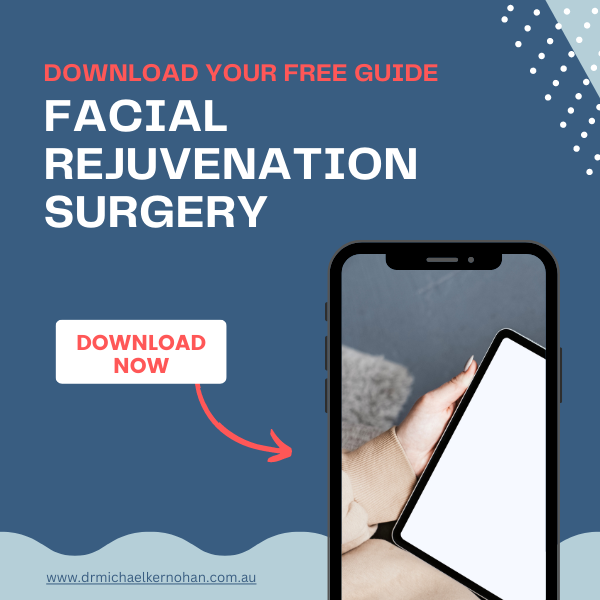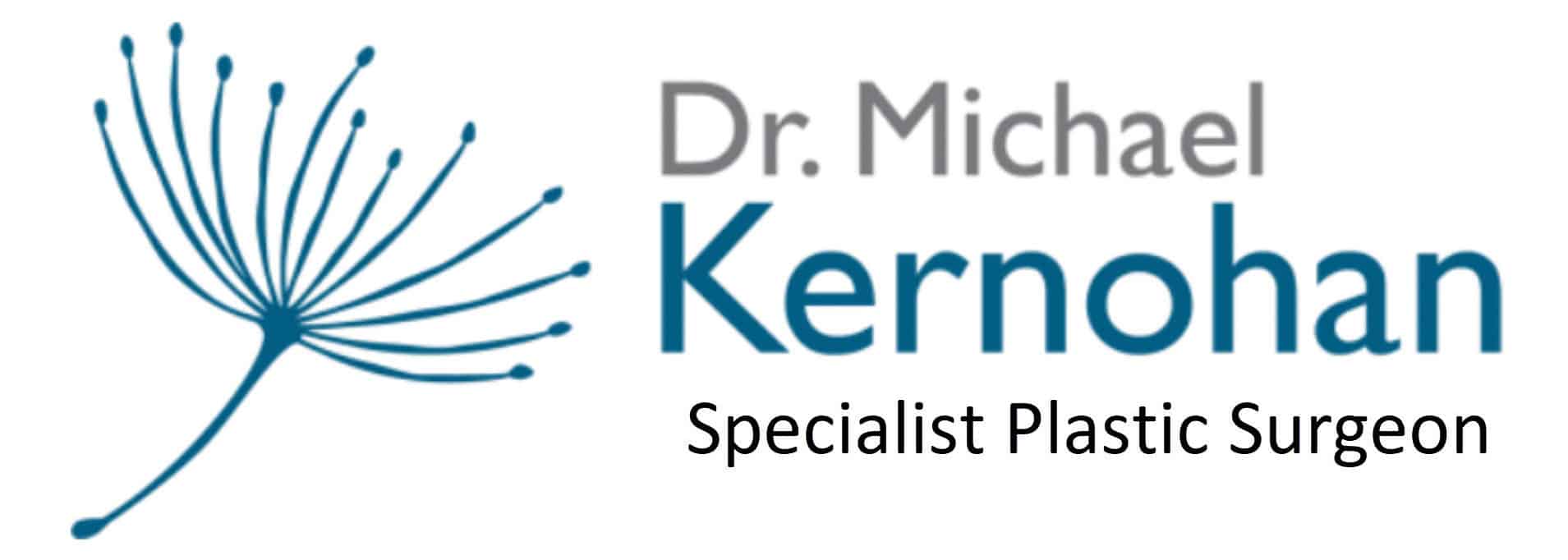Saggy Eyelids – Do I need an Eyelid Lift Surgery or Forehead Lift ?
Some patients chose blepharoplasty to address the excess skin and puffiness in the upper and lower eyelids. In contrast, other patients chose a forehead lift to gloss out the wrinkles on the forehead and elevate the eyebrows. In this blog, we’ll discuss blepharoplasty vs forehead lift – what to expect from each procedure.
Specialist Plastic Surgeon Dr Michael Kernohan is an experienced plastic surgeon performing both blepharoplasty and forehead lift. With his keen eye for detail and commitment to patient satisfaction, he can help you make an informed decision and achieve the desired results.
Click to Download Dr Michael Kernohan’s Facial Rejuvenation Guide

What Is Blepharoplasty?
The goal of blepharoplasty, called eyelid surgery, is to alter the look of the upper and lower eyelids. The process entails removing extra skin, fat, and muscle. Blepharoplasty can also be performed to improve vision in cases where drooping eyelids interfere with sight.
What Is Forehead Lift?
A forehead lift, also known as a brow lift, is a cosmetic surgery that addresses sagging eyebrows, deep wrinkles, and furrows in the forehead. The procedure involves incisions along the hairline or in the scalp, allowing for repositioning the eyebrows to an elevated position. A forehead lift can also smooth out wrinkles in the forehead.
Who’s A Good Candidate For Blepharoplasty And Forehead Lift?
Blepharoplasty and forehead lift are cosmetic procedures that can improve the appearance of the upper part of the face. Both procedures are designed to address common signs of ageing, including droopy eyelids, deep wrinkles, and sagging eyebrows. However, not everyone is an eligible candidate for these procedures.
- Blepharoplasty: a good candidate for blepharoplasty is someone who is in good health and has droopy or puffy eyelids. Candidates should also have realistic expectations for the procedure and understand that blepharoplasty can only address specific aspects of the ageing process. Additionally, candidates should not smoke, as smoking can increase the risk of complications and slow the healing process
- Forehead Lift: a good candidate for a forehead lift is someone who has sagging eyebrows, deep wrinkles, or furrows in the forehead. Candidates should understand that a forehead lift can only address certain aspects of the ageing process
Patients need to consult with a qualified plastic surgeon to determine if they are a good candidate for blepharoplasty or forehead lift and to discuss the best options for their individual needs and goals. To decide if blepharoplasty or forehead lift is the best action method for the patient, your surgeon will consider the medical history, skin condition, and eyes shape.
Why Do People Consider Blepharoplasty And Forehead Lift?
As we age, our skin and tissues start to sag, wrinkles and lines form, and our eyebrows may droop. These changes are a natural part of the ageing process. They are brought on by a number of things, including as heredity, sun exposure, and lifestyle decisions like smoking and drinking.
Blepharoplasty vs. Forehead Lift
- Before the procedure
Both blepharoplasty and forehead lift require similar preparation, including choosing the right surgeon, signing informed consent, following preoperative instructions, and being mindful of medications and supplements. However, each procedure will also have its own unique preparation requirements, which will be discussed in detail during your consultation with your surgeon.
- During the procedure
Blepharoplasty is typically performed under local anaesthesia or intravenous sedation, while a forehead lift is usually performed under general anaesthesia. During a blepharoplasty, your surgeon will make small incisions in the upper or lower eyelids and remove excess skin and fat. In some cases, the surgeon may also tighten the muscles and reposition the fat in the eyelids.
On the other hand, a forehead lift involves making incisions in the scalp and lifting the skin and underlying tissues of the forehead to improve the appearance of sagging eyebrows, deep wrinkles, and furrows.
- Recovery
Blepharoplasty recovery typically takes 1-2 weeks, during which time you may experience swelling, bruising, and some discomfort. You should avoid strenuous activity and exposure to the sun during this time and follow your surgeon’s postoperative instructions carefully.
Forehead lift recovery typically takes 1-2 weeks as well, during which time you may experience swelling, bruising, and some discomfort. Additionally, you’ll need to wear a bandage or compression garment to lessen swelling and support the tissues as they heal.
What Procedure is Right for Me?

The recommendation for either procedure will depend on your individual needs and goals. If you are primarily concerned with the appearance of your eyelids, blepharoplasty may be the right option for you. Suppose you are more concerned with sagging eyebrows, deep wrinkles, and furrows in the forehead. In that case, a forehead lift may be the best option. Both procedures can produce natural-looking results.
So, to get optimal results, choosing a specialist plastic surgeon with experience performing the procedure is important. Additionally, it is important to follow the surgeon’s post-operative instructions carefully and to give your body enough time to recover.
How Can I Tell If I Need Blepharoplasty?
If you are considering blepharoplasty, you may be experiencing one or more of the following symptoms or concerns:
- Sagging or Drooping Eyelids: you could be a candidate for blepharoplasty if your upper eyelids sag over your lashes and impair your eyesight. This condition can be caused by ageing, genetics, or a combination of the two
- Puffy or Baggy Eyelids: if your upper eyelids appear puffy or baggy, even when you are well-rested, you may be a good candidate for blepharoplasty. This can be due to excess fat deposits in the eyelids
- Fine Lines and Wrinkles: if you have fine lines and wrinkles around your eyes, you may be a good candidate for blepharoplasty
- Excess Skin: if you have excess skin in your upper or lower eyelids, you may be a good candidate for blepharoplasty
What Are The Signs That I Need A Forehead Lift?
You may be experiencing one or more of the following symptoms or concerns if you are considering a forehead lift:
- Sagging or Drooping Eyebrows: if your eyebrows have begun to sag, you may be a good candidate for a forehead lift
- Deep Forehead Wrinkles: if you have deep wrinkles in your forehead, you may be a good candidate for a forehead lift
- Frown Lines: if you have deep frown lines between your eyebrows
- Low-Set Eyebrows: if your eyebrows have begun to set low on your forehead
Suppose you are experiencing one or more of these symptoms or concerns. In that case, it is important to schedule a consultation with Dr Michael Kernohan. He will assess your needs and help you determine if a blepharoplasty or forehead lift is right for you.
FAQs about Blepharoplasty and Forehead Lift
What do eyes look like right after Blepharoplasty or Forehead Lift?
- After a forehead lift or blepharoplasty, expect some swelling and bruising around the eyes. This is a natural part of the healing process and should go away in a few days to a week. You may also suffer some discomfort, which can be treated with pain medication. Bandages and/or special tapes may also be applied to your eyes to protect the incisions and encourage healing. Your surgeon will provide you with specific postoperative care and follow-up instructions, such as when to remove the bandages and when to return for a follow-up consultation. To achieve an optimal result, following your surgeon’s directions carefully is critical. The swelling and bruising will fade over time, and you will begin to notice the ultimate benefits of the operation.
Are you awake during Blepharoplasty or forehead lift?
- Blepharoplasty and forehead lift are typically performed under local anaesthesia with sedation or general anaesthesia. This means that you will feel no pain, whatever type of anaesthesia is chosen for your procedure. Local anaesthesia with sedation will numb the area around your eyes, and you will be relaxed but awake during the procedure. General anaesthesia will put you to sleep for the duration of the surgery. Your surgeon will determine the type of anaesthesia used. It will depend on the extent of the procedure, your medical history, and your personal preferences. Your surgeon will discuss the options with you and help you determine the right choice for your needs. Regardless of the type of anaesthesia used, you will be closely monitored during the procedure to ensure your safety and comfort. You will be watched in a recovery area following the surgery until you are completely awake and prepared to return home.
Is Blepharoplasty recovery painful?
- Most patients report experiencing some mild to moderate discomfort and tenderness around the eyes, forehead, or temples. This can be managed with over-the-counter pain medication or prescription pain medication, as directed by your surgeon. It is essential to follow your surgeon’s postoperative instructions carefully, including taking all medications as prescribed, attending all follow-up appointments, and avoiding any strenuous activities until your surgeon clears up. While recovery from blepharoplasty or forehead lift can be uncomfortable, most patients report that the results are well worth the temporary discomfort. The discomfort will subside with proper care, and you can enjoy your refreshed and rejuvenated appearance.
Is Forehead Lift major surgery?
- While it is not a major surgery in the sense that it involves a large incision or a prolonged hospital stay, it is still a surgical procedure that requires careful planning and attention to detail.
Further Reading about Eyelid Lift Surgery
- Read Dr Kernohan’s Upper Eyelid Lift Surgery Page
- Read Dr Kernohan’s Lower Eyelid Lift Surgery Page
- Read Dr Kernohan’s blog about Solutions for Sunken Eyes
- Read Dr Kernohan’s blog about What Are Hooded Eyes?
- Read Dr Kernohan’s blog about How to Fix Tired Eyes





